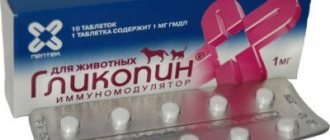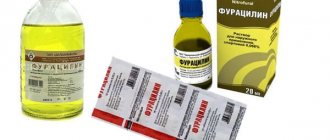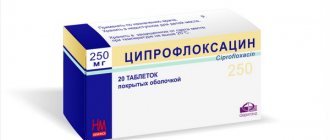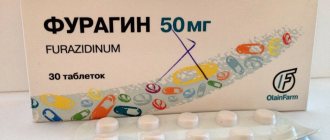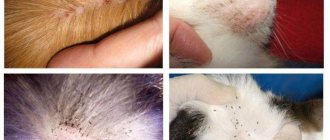8679Pavel
1
Furosemide from Latin, Furosemidum, is a fast-acting diuretic (diuretic), which contains the active ingredient of the same name. Widely used in veterinary medicine for cattle, farm animals, as well as cats and dogs. Depending on the degree of the disease, different dosages are used for treatment. Furosemide for cats and dogs is prescribed by a veterinarian based on body weight. They usually start with intramuscular injections, and when the necessary results are achieved, they switch to taking pills until complete recovery.
Chemical composition and characteristics
Furosemide is a diuretic, which means it helps remove urine from the animal’s body. The drug blocks the absorption of sodium and chlorine ions, which retain fluid in the body. As a result, water is excreted along with potassium, calcium and magnesium ions.
According to the degree of impact on the animal’s body, the product belongs to the class of moderately hazardous substances (class 3). In addition to the main active ingredient of the same name, Furosemide contains components that help the medicine to be better absorbed. They are listed below in the table.
| Tablet | Solution |
| povidone | sodium metabisulfide |
| lactose | sodium hydroxide |
| MCC | water for injections |
| gelatin | methyl parahydroxybenzoate |
| potato starch | propyl parahydroxybenzoate |
| colloidal silicon dioxide | |
| magnesium stearate | |
| talc |
Description of release form
Furosemide is available in tablet form and as a solution for injection.
Important! Self-treatment of your pet with Furosemide can lead to negative consequences. The drug should be given only after examination and prescription by a veterinarian.
Pills
The tablets are produced white, round, flattened. Packed in 10 or 25 pieces. Each individual unit contains 40 mg of the active ingredient (furosemide).
Solution
A 5% solution for intramuscular and intravenous injections is a clear liquid from colorless to light yellow. Available in dark glass bottles of 50 or 100 ml. The containers are tightly closed with rubber stoppers and secured with aluminum caps on top. 1 ml of the drug contains 50 mg of active substance.
Storage conditions and shelf life
The standard requirements for storage conditions of the drug are:
- temperature regime of the liquid form of release - 5-25 degrees (closed bottle), 2-8 degrees (after opening the bottle);
- dark place;
- lack of open access for children and animals.
Furosemide retains its pharmacological properties for two years, taking into account the date of production of the product. After opening the bottle, the period is reduced to 28 days.
The shelf life of the tablet drug is 2 years.
Indications for use of the drug
Furosemide is prescribed to cats when they develop swelling caused by the following reasons:
- severe form of hypertension;
- cirrhosis of the liver;
- with edema of the lungs, heart, brain;
- accumulation of fluid in the abdominal cavity due to liver disease;
- chronic heart failure;
- abnormal kidney function;
- intoxication or poisoning.
Furosemide is given to cats for severe hypertension
Instructions for use and dosage in veterinary medicine
The required dose of the drug is prescribed by the veterinarian, based on how much the animal weighs, what disease it has and how severe its condition is. The average dose of the drug per day is 5-6 mg per 1 kg of body weight in tablet form. In the form of injections - 0.5–0.6 ml per 10 kg of weight. But if necessary, the dosage can be doubled. The medicine should be given 30–40 minutes before meals.
Important! Complete analogues of "Furosemide" are drugs
"
Lasix
"
and
"
Salix
"
, which can be replaced with each other.
special instructions
To achieve the required therapeutic effect, you must strictly follow the dosage and the veterinarian's instructions. Injections of the drug are made in the usual way, but the solution cannot be mixed with other drugs in the same syringe. Furosemide can be used in combination with other medications, with the exception of cephalosporin antibiotics, heart medications and Gentamicin.
You cannot mix the solution with other products in the same syringe.
Cats and dogs treated with MI require monitoring of kidney function and monitoring of the concentration of sodium, potassium and other minerals in the body, as they are flushed out along with excess fluid.
With long-term use, the drug can cause changes in blood composition and other serious pathologies, so long-term treatment is best avoided. If the drug does not provide the required therapeutic effect, you should contact your veterinarian and replace it with another one.
In case of renal failure in cats and dogs, Furosemide has a more symptomatic than therapeutic effect, so it is impossible to treat the disease exclusively with diuretics - it is necessary to find its cause and apply an integrated approach.
The shelf life of Furosemide is 2 years; after opening the bottle of solution, it is reduced to 28 days. The drug should be stored at a temperature not exceeding 25 degrees in a dark place, protected from children and animals. An open bottle of solution should be kept in the refrigerator at a temperature of 2-8 degrees.
Attention!
When using Furosemide in animals, urination becomes more frequent and the volume of urine increases - this is the norm and indicates that the drug provides the necessary therapeutic effect.
Precautions and application features
When working with Furosemide, you should adhere to certain precautions and take into account the particularities of use, which include the following:
- the course of taking the drug should not exceed 10 days;
- It is not recommended to give to cats during pregnancy (only in case of emergency it is allowed in the 3rd trimester) or feeding;
- it is necessary to strictly adhere to the treatment regimen and not skip medication, as this may reduce the therapeutic effect;
- It is not advisable to give Furosemide simultaneously with other medications;
- Do not use the medicine after the expiration date;
- When working with an injection drug, you must adhere to the rules of personal hygiene (carefully wash your hands and face with soap), use rubber gloves;
- destroy used bottles without using them for other purposes.
Did you know? Residents of Great Britain and Australia believe that black cats bring only good luck.
Contraindications and side effects
Side effects from the medicine occur as a result of exceeding the required doses or violating the dosage regimen. As a result, the animal may experience:
- thirst;
- lethargy or agitation;
- vomiting or diarrhea;
- loss of appetite;
- hearing loss;
- tilting the head to the side;
- dehydration;
- rapid pulse;
- limb spasms.
Side effects include decreased appetite.
The drug is contraindicated in the following cases:
- liver failure;
- renal failure;
- urolithiasis disease;
- myocardial infarction, narrowing of the aorta or mitral valve;
- violation of water-salt metabolism or acid-base balance;
- low potassium levels in the blood;
- allergy to one of the components of the drug.
Learn about common cat diseases and how to treat them.
Furosemide for cats with urolithiasis
Treatment of urolithiasis in cats is a very painstaking procedure.
You should definitely contact a veterinary clinic for advice if you notice a deterioration in your pet’s condition. Urolithiasis is also called urolithiasis or, in short, UCD. This is when a cat's bladder fills with sand or stones form in his kidneys. Harmful substances are retained in the ureter or pass with severe pain. With this disease, blood is observed in the cat's urine.
Of course, accepting such a fact is painfully difficult, but necessary. Therefore, many people wonder how to treat urolithiasis in cats. But first you need to figure out who is at risk.
- Males are more susceptible to urolithiasis than cats. Since cats have a narrow lumen of the urinary canal, and the opposite is true for female pets;
- Neutered pets;
- Overweight cats;
- Age category from 2 to 6 years.
This means that 12% of cats are at risk of developing this disease. Disorders of the genitourinary system or poor metabolism lead to the formation of stones and sand, which are not easy for four-legged animals to tolerate.
Veterinarians have conducted numerous observations and claim that in early autumn and between January and May, urolithiasis in cats worsens significantly.
Why does urolithiasis occur?
Urolithiasis occurs in cats for a number of reasons:
Symptoms and signs of ICD manifestations
In the first days, symptoms of urolithiasis in cats appear weakly and unnoticeably. Therefore, owners do not immediately notice the malaise of their pets. Consequently, treatment begins at the wrong time.
There are some changes to the daily existence of a cat:
- He begins to lick under his tail frequently;
- Urination occurs frequently and for a long time;
- While visiting the toilet, the cat begins to meow, allegedly complaining of discomfort.
If a cat has urolithiasis, then every day his condition will worsen. Stones and sand will increase, move, and subsequently the passage will be partially or completely blocked. Here the symptoms will begin to appear more clearly:
- Restless feeling and sudden mood swings;
- Abdominal enlargement, but weight loss;
- The cat may become incontinent, which leads to urination in inappropriate places;
- Blood clots will be visible in the urine.
There are also critical signs when a cat needs emergency treatment:
- He stops going to the toilet altogether;
- He doesn’t eat anything, but he is overtaken by vomiting;
- Convulsions occur;
- The cat loses consciousness.
Remember that treating urolithiasis in cats at home is strictly prohibited! If the first signs are noticed, you should immediately seek help from qualified veterinarians.
They will carry out special procedures that will help identify urolithiasis or its absence. For example:
- Ultrasound of the bladder;
- Urine test;
- Plain or contrast X-ray;
- Instant Invasion;
- In isolated cases, palpation is performed.
Some owners engage in self-diagnosis to identify urolithiasis. Fill a plastic glass with cat urine and place it in a bright place to see whether a sediment forms or not.
But this is an unreliable analysis. Since sediment is formed due to natural influence . Therefore, using the “grandmother’s method” makes no sense.
Quality treatment is necessary.
Methods for treating urolithiasis
When the owner notices the primary signs of the development of the disease, before going to the veterinarian, he can relieve the spasms and prevent a severe attack from happening. You will need to place a slightly heated heating pad in the abdomen and perineum of your pet.
But massaging the furry belly is not recommended, as the four-legged’s well-being may worsen. Which will lead to complications.
We must not forget that cats do not tolerate urolithiasis well. And if you delay going to the clinic for treatment, the pet may die within three days.
There are some rules according to which treatment is carried out:
- The acute phase is stopped;
- The outflow of urination is restored. A catheter is used to remove stones or sand. In rare cases, surgery is performed;
- Droppers are prescribed to relieve intoxication spasms and eliminate dehydration;
- Anti-inflammatory treatment is carried out;
- Finally, anti-infective drugs or vitamins are prescribed.
Plus, specialists can offer conservative or surgical treatment. But this will depend on the number and size of stones.
The surgical treatment for urolithiasis involves the cat being under general anesthesia. This makes it possible to remove stones with extreme precision. Therefore, send them for tests that can identify the true factor of occurrence. Then you can avoid reappearance.
Conservative treatment - pain relief and the desire to dissolve stones with the help of diet or medications. This method can be called gentle, but the likelihood of dissolving stones is low.
The type of treatment must be prescribed by a veterinarian. After diagnosis, he will determine the condition of the cat, the type and number of stones formed. Based on the indications of these factors, treatment will proceed.
At home, the owner must strictly follow the recommendations of the treating specialist in order to avoid deterioration and death. Most likely, antibiotics will be prescribed, a balanced diet and a second test will be prescribed.
When the cat's urolithiasis subsides, the doctor will institute diet therapy and medical examination.
Drugs that help in the treatment of urolithiasis
It is worth remembering that medication treatment is prescribed by a veterinarian. They often use drugs such as:
- Capsules "Uro-Ursi". Prescribed for antibiotic treatment. Helps get rid of urolithiasis.
- Additive "Cistokur forte". Reduces acid in the body and the cat recovers faster after treatment.
- Stop cystitis tablets. Act as an antimicrobial, anti-inflammatory and analgesic.
- The drug "Urotropin". This is a diuretic that promotes rapid elimination of toxins.
- Liquid "Furinide". Creates an immune film on the bladder.
- Solution and tablets "Kantaren". Relieves spasms and kills inflammation.
- Ipakitine powder. It is prescribed without fail in the treatment of urolithiasis.
- Infusion "Kotervin". Removes salts and dissolves stones.
- Renal Advance powder. Prescribed for the treatment of the last stages of urolithiasis. Plus, it improves digestion.
Price and analogues
The cost of Furosemide differs depending on the dosage form. So a bottle (50 ml) of a 5% solution costs 14.70 rubles, and tablets (50 pcs.) cost from 26 to 32 rubles. If necessary, the drug can be replaced with similar drugs, such as:
- "Torasemide" - has a long-term effect (up to 18 hours), but can lower blood pressure;
- "Indapamide" - relieves swelling well and is inexpensive, but less effective than "Furosemide";
- “Amiloride” is gentle and long-lasting (24 hours), but it is necessary to regulate the level of potassium in the blood;
- "Triamterene" - practically does not cause side effects, but is poorly soluble in water;
- “Hypothiazide” is a potent substance that does not interfere with the functioning of the kidneys and liver, but is available only in the form of a solution;
- “Veroshpiron” is well absorbed into the blood, does not wash away potassium, but can lead to its excess.
It is necessary to replace one medication with another only after examination by a veterinarian
Duration of action of Furosemide
In case of edema, Furosemide will cure a cat quickly, but only if all the doctor’s instructions are followed. Depending on the method of application, the speed of action of the medicine varies. When taking the tablet, the onset of action is within 15-30 minutes, and the effect lasts 6-8 hours.
When administered intramuscularly, the effect begins within 5-10 minutes, and the result is observed within 1.5-2 hours. Injections work much faster than tablets, but only a doctor determines what type of procedure a cat needs.
© shutterstock


